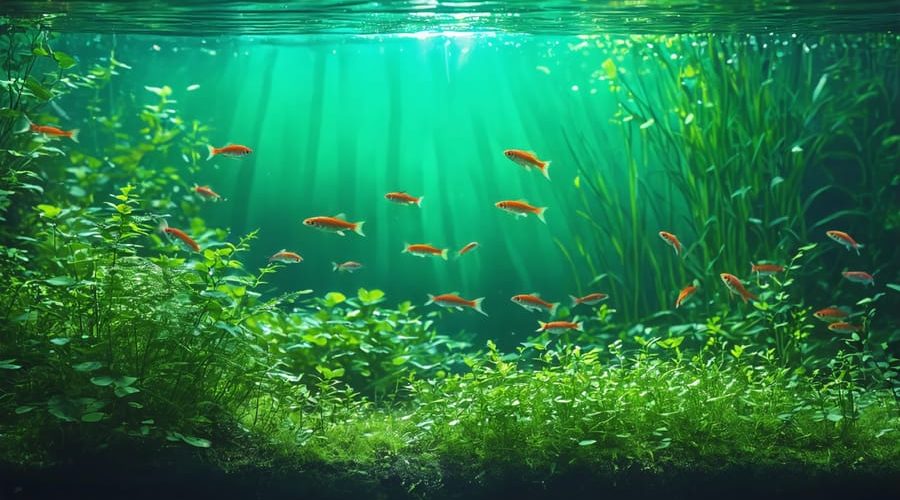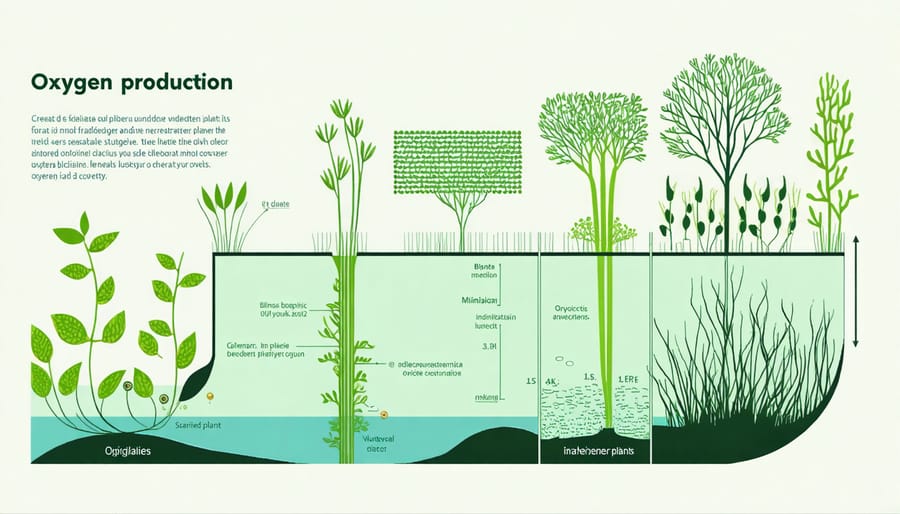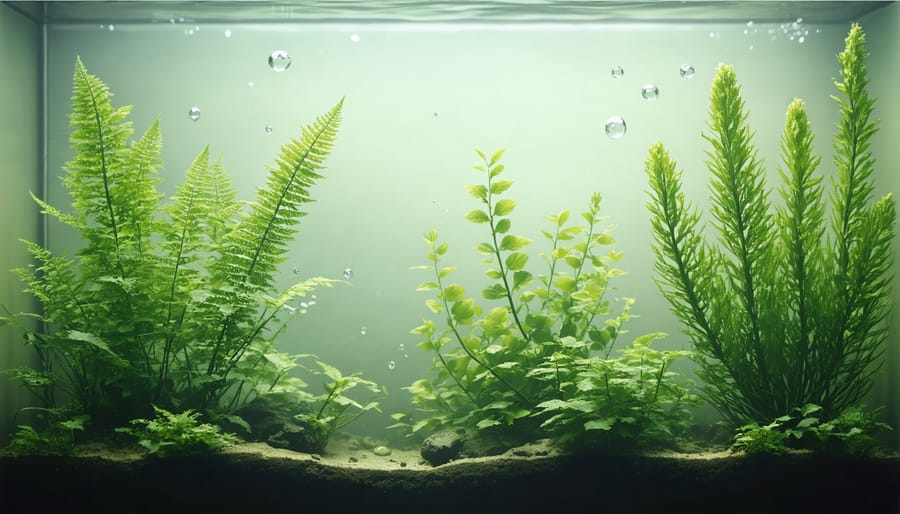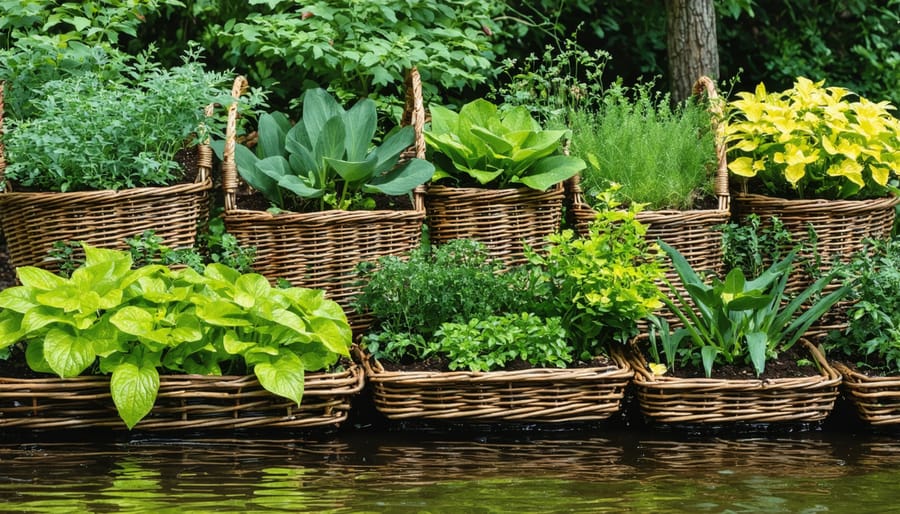
Natural Pond Oxygenation: How These Plants Keep Your Fish Thriving
Transform your pond into a thriving aquatic ecosystem by strategically introducing oxygenating plants – nature’s own water purifiers. These essential aquatic plants work tirelessly beneath the surface, releasing oxygen during photosynthesis while absorbing excess nutrients that could otherwise fuel algae growth. Beyond maintaining healthy water conditions, oxygenating plants create vital hiding spots for fish and provide natural filtration that keeps water crystal clear. Whether you’re setting up a new pond or enhancing an existing one, understanding how to harness the power of these underwater workhorses will revolutionize your water garden’s health and beauty. From deep-water varieties like Hornwort to floating specimens such as Water Lettuce, each species plays a unique role in creating the perfect balance for your aquatic paradise.
How Oxygenating Plants Support Your Pond Ecosystem
The Science Behind Plant Oxygenation
The magic of oxygenating pond plants lies in the remarkable process of photosynthesis. During daylight hours, these aquatic plants absorb carbon dioxide and sunlight, converting them into energy and releasing oxygen as a byproduct. This natural process is crucial for maintaining a healthy pond ecosystem. Think of these plants as nature’s own oxygen factories!
The leaves and stems of submerged plants release tiny oxygen bubbles directly into the water, which you might sometimes see rising to the surface. This continuous oxygen production helps maintain optimal oxygen levels for fish and other aquatic life, especially during warm summer months when oxygen naturally decreases in water. The process is most active during sunny days, though plants will consume some oxygen at night. That’s why having the right balance of oxygenating plants is key to maintaining crystal-clear, healthy pond water that your fish will love.

Benefits Beyond Oxygen
Oxygenating plants offer far more benefits than just bubbling oxygen into your pond. These aquatic powerhouses act as natural filters, absorbing excess nutrients like nitrogen and phosphorus that could otherwise fuel unwanted algae growth. Think of them as your pond’s cleanup crew, helping maintain crystal-clear water naturally.
These plants also provide valuable shelter for fish and other pond wildlife, creating safe spaces for spawning and hiding from predators. Their roots help stabilize the pond bottom and trap floating debris, further improving water clarity. Many species even help regulate water temperature by providing shade, which is especially beneficial during hot summer months.
As an added bonus, most oxygenating plants require minimal maintenance once established. They work tirelessly in the background, creating a balanced ecosystem that practically maintains itself. Plus, their underwater foliage adds an interesting visual element to your pond, creating depth and movement beneath the surface.
Best Oxygenating Plants for Your Fish Pond
Submerged Oxygenators
Submerged oxygenators are the workhorses of a healthy pond, living entirely underwater where they produce oxygen throughout the day. These amazing plants not only release oxygen directly into the water but also provide shelter for fish and help prevent algae growth by competing for nutrients.
Some of the most effective underwater oxygenators include Hornwort, which is incredibly easy to grow and maintains its green color year-round. Elodea (also known as waterweed) is another fantastic choice, producing tiny white flowers that peek above the surface while its stems remain submerged. Water Milfoil is particularly good at filtering excess nutrients, making it a dual-purpose addition to your pond.
To get the best results from your submerged oxygenators, plant them in small bunches weighted down with a stone or planted in mesh baskets with aquatic soil. For every square meter of pond surface, aim to include about 3-5 bunches of oxygenating plants. During the growing season, these plants will multiply quickly, so don’t worry about starting with too few.
Remember to trim these plants regularly to prevent them from taking over your pond, especially during summer months when growth is vigorous. The trimmed portions can be composted or, better yet, left at the pond’s edge for a day so any small creatures can make their way back to the water.

Floating Oxygenators
Floating oxygenators are nature’s multitaskers, providing both oxygen and natural shade for your pond while requiring minimal maintenance. These plants float freely on the water’s surface, making them an excellent choice for ponds of any depth.
Water lettuce and duckweed are popular floating oxygenators that quickly spread across the water’s surface. Their long, feathery roots hang down into the water, absorbing excess nutrients while releasing oxygen. Frogbit, with its small lily pad-like leaves, is another fantastic option that adds visual interest while helping maintain healthy oxygen levels.
One of the best things about floating oxygenators is their ease of care – simply place them on the water’s surface and let nature do the rest! However, keep in mind that some floating plants can be vigorous growers. During summer months, you may need to thin them out to prevent overcrowding, which can actually reduce oxygen levels if left unchecked.
For the best results, aim to cover about 50-60% of your pond’s surface with floating plants. This balance allows enough sunlight to reach submerged plants while maintaining adequate oxygenation and providing shelter for pond life. In winter, most floating oxygenators will naturally die back, but they’ll return in spring when temperatures rise.
Remember to choose native species when possible, as some floating plants can become invasive in certain regions.
Planting and Maintenance Tips
Planting Techniques
Introducing oxygenating plants to your pond is straightforward when you follow these proven techniques. Start by removing any packaging and gently rinsing the plants to remove excess soil or debris. For submerged plants, like Hornwort or Elodea, bundle them together in groups of 3-5 stems using plant weights or rubber-coated metal strips.
For potted varieties, use aquatic planting baskets lined with hessian or pond liner to prevent soil leakage. Fill the baskets with aquatic compost, leaving about an inch at the top. Position your plants carefully, ensuring the crown sits just above the soil level, then top with gravel to prevent floating.
When placing plants in your pond, remember that different species thrive at various depths. Submerged oxygenators should rest at the bottom, while marginal plants need shallow shelves. Space plants about 2-3 feet apart to allow for growth and proper water circulation.
For floating plants like Water Lilies, simply place them directly on the water’s surface. They’ll naturally spread as they establish themselves. During the first few weeks, monitor your plants closely and remove any yellowing or decaying leaves to maintain water quality.
If planting in spring or summer, expect to see new growth within 2-3 weeks. Autumn plantings may take longer to establish but will flourish come spring.

Seasonal Care Requirements
Maintaining oxygenating pond plants requires different approaches throughout the year to ensure they thrive and continue benefiting your pond ecosystem. In spring, gently remove dead foliage and trim back any overgrowth from the previous season. This is also the perfect time to divide and replant rapidly growing species to prevent overcrowding.
Summer brings peak growth, requiring regular monitoring of plant density. While these plants are vital for oxygen production, too much growth can block sunlight and reduce oxygen levels overnight. Aim to maintain about 60-70% plant coverage of your pond’s surface area. Remove any yellowing or dying vegetation promptly to prevent decay.
As autumn approaches, reduce feeding and begin preparing plants for winter dormancy. Remove fallen leaves before they sink and decompose. Some floating oxygenators might need thinning to prevent them from dying off and releasing nutrients into the water.
Winter care is minimal, but crucial. Avoid breaking ice on the pond’s surface as this can shock fish and damage plants. If your area experiences harsh winters, consider moving potted oxygenating plants to deeper water where they’re less likely to freeze. Leave dead foliage until spring, as it provides valuable shelter for pond life during colder months.
Remember that seasonal maintenance should be gentle and gradual to maintain the delicate balance of your pond’s ecosystem.
Common Challenges and Solutions
Even the best-maintained ponds can face challenges with oxygenating plants. One common issue is excessive growth, where plants like Elodea or Hornwort can take over your pond. The solution is regular trimming, especially during summer months, to maintain about 60% plant coverage of your pond’s surface.
Algae competition often poses another challenge, as it can outcompete your oxygenating plants for nutrients. Combat this by introducing floating plants like water lilies to provide shade and installing a basic filtration system. If algae persist, consider adding barley straw, which naturally helps control algae growth.
Plant yellowing or dying off might occur due to poor water quality or insufficient sunlight. Test your water parameters regularly and ensure plants receive at least 4-6 hours of direct sunlight daily. In shaded areas, opt for shade-tolerant species like Anacharis or Canadian Pondweed.
Some pond owners struggle with plants becoming uprooted, especially in ponds with active fish. Secure plants by using planting baskets with aquatic soil and a layer of gravel on top. For smaller species, try anchoring them to stones until they establish strong root systems.
During winter, many oxygenating plants naturally die back. Don’t panic – this is normal. Leave some plant matter in the pond as winter shelter for wildlife, but remove excess debris to prevent water quality issues when spring arrives.
Adding oxygenating plants to your pond is one of the best decisions you can make for a healthy aquatic ecosystem. These natural oxygen generators not only keep your water clean and clear but also create stunning underwater landscapes that enhance your pond’s beauty. By choosing a mix of submerged and floating plants, you’ll create a self-sustaining environment that requires minimal maintenance. Remember to start small and gradually increase your plant collection as you become more comfortable with pond maintenance. Whether you’re a beginner or experienced pond keeper, incorporating these oxygen-producing plants will transform your water feature into a thriving habitat for fish and wildlife. Take the first step today by selecting a few starter plants, and watch as your pond comes alive with natural vitality.
